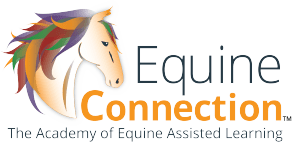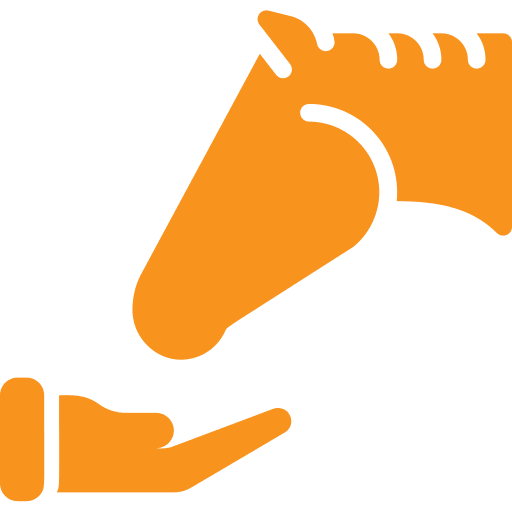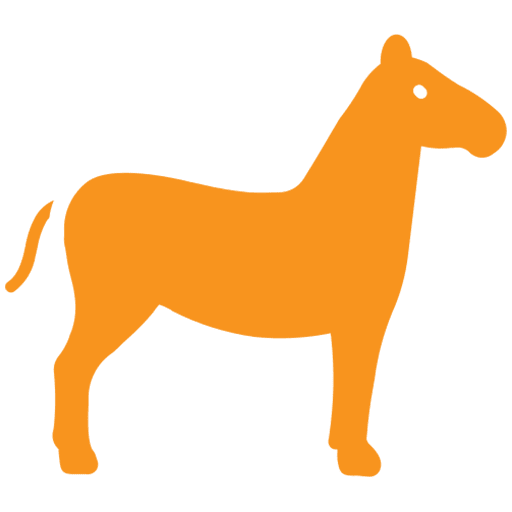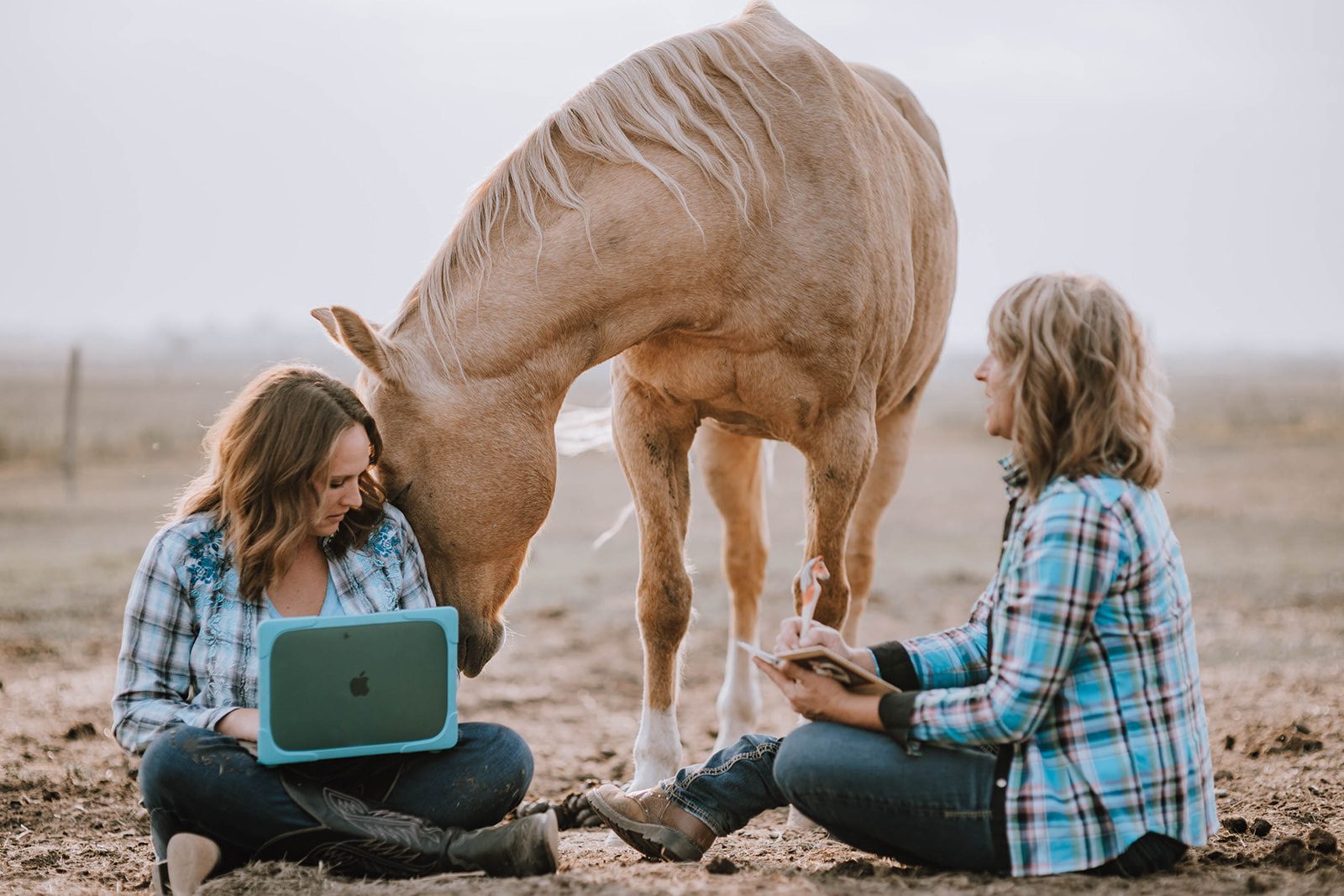Join Equine Connection's FREE "Email Newsletter" Made For Horse Lovers & Equine Business Alike….
It’s all about the horse today. And I have to tell you, this is my favorite topic. It’s really because we could actually do a live show every week on something to do with the horse. Because I’ve always said, I don’t think we’ll ever gain all the knowledge that we’re starting to understand, even in our lifetime, it’s so in-depth. There is so much to understanding horse culture and their language. You never stop learning and wanting to understand them even more.
Embracing Equine Wisdom
Hopefully today we will hit a few of the main need to know items, key ones that can be used by any of you who have a horse and want to understand them better. You want to understand their language and not our human language.
You know, I do have to tell you that Equine Connection has been around since 2008. We literally have let the horse be the teacher for all of these years. This is why it is such a profound time. Every time we bring in the horse language and understand their culture and their language, we’re doing the horse more justice and also the human.
Bridging the Human-Equine Communication Gap
We need to remember as a human we think differently, if you were suddenly a horse you’d have no clue how to communicate with the other horses due to the fact everything in their lives is different. Their feelings are different, their constitution is different. Take a look at the human brain and compare it to the horse. The horse brain has a different function altogether. Don’t forget we are a predator and they are prey, immediately there we see that the primitive brain is more developed. Their goal is survival.
Instinctual Responses: Understanding Equine Behaviour
We have adapted over the years to being the number one predator on the planet. Our primitive (or reptilian brain has shrunk) we do not need to use it and consequently at a lot of times, don’t.
The horse goes by instinct, which is why we are always coming back to the safety factor. A horse needs to feel safe. It is constantly number one for a horse. They’re not thinking I wonder if Amy has gone to buy me more of the crunch cookies. Why doesn’t she understand I much prefer the Equine Developer pellets? They’re not making up their shopping list for you or wondering if you’ll stop by for a visit. They’re eating grass, hay or having a nap, sleep, going through whatever other bodily functions they perform to live. Be a horse for a moment. Where are you? If you’ve wandered off you’re in your human brain. If you’re sitting still thinking of nothing, you’re a horse. It isn’t until you hear a bang that your head raises and you discern whether you are unsafe. This is pretty much the horse’s life, do I carry on eating or should I run?
No anthropomorphic emotions going on there. Yes, they grieve, yes, they bond with another horse, yes, they bond with a human and as you will learn further into this there are other things going on that only relate to them as being a horse.
Equine Sensory Proficiency: Exploiting Olfactory and Tactile Abilities
One thing to keep in mind and it’s a fact, it’s something that we need to be aware of, that horses can only breathe through their nose. As humans, we have the ability to use our nose and mouth to breathe. Whilst horses can only do that through their noses. They’re not even designed to breathe in through their mouths. So keep that in mind because not only is it important that we know that medically but also for us as humans to understand the following. When we use our nose to breathe and breathe the proper way, it actually brings down our heart rate, it makes us feel at home, in a much calmer place, kind of like where a horse is. That’s why horses are known as healers, because they’re so calming.
Exploring Equine Communication: Deciphering Horse Behaviour
I have a question here for you: are any of you guys animal communicators? Not in the sense that you can tune in like a radio station but we have met some who are so intuitive that they have some understanding. They are gifted. But we are animal communicators too in that sense.
However, we are into communicating with our horses to understand how they’re communicating with us and what their true language is. We take the welfare of the horse into account every single time by making sure we’re looking into where the horse is at. It’s up to the people to know their stuff. People have to come to see these pieces themselves.
Interpreting Equine Behavior: Navigating Nonverbal Communication
If somebody says, this horse loves me so much, and the horse’s nostrils are flared and their ears are pinned and their head is high, okay, let’s take a look at that body language for just a quick second. Let’s figure out where your horse actually is. Now, it doesn’t mean that the horse doesn’t like you because they don’t think in that way. But we have to figure out exactly where our horse is right now, so we have the actual understanding of it. We can’t blow sunshine either.
And that’s being professional because you can’t let them do what they like whilst around us or others. Again, we always think of it this way. Our horses, we know the number one thing they need is to feel is safe. So an outsider, a non-horse person, a person in recovery coming into our arena and telling us that the horse needs love, well, that’s absolutely not true. We already know it’s not true. So we have to help the person, by the step-in.
Equine Memory and Body Language: Insights into Equine Psychology
So the first thing to think of and I did bring this little horsey bit in so we remember some of the body parts, but with their little brain that they have, one thing to keep in mind is they do havestack memory. So that would be very similar to a human being. They have memories. Even though horses live in the moment, they don’t think of the past not like a human. Where, oh, you know, if I could just change that, that mare would have been so much nicer to me. They don’t think in the past and they never think of the future. They live in a moment. But they have stacked memories. And what stack memory is, they actually are known to have one of the strongest memories in all of the animals. So it makes logical sense when a horse. Let’s say, for example, I’ve heard this a lot, my mare does not like me. There’s a perfect example where the mare sees this man, where it brings the stack memory to the forefront. She sees the picture just like us. If you close your eyes, what you see is, you’re pulling forth pictures. We’re not seeing anything but a picture. That’s our stack. Memory is pictures. We’re the results of our lives.
Understanding Equine Memory
The horse has memories from her past and I have mine from my past, because that’s how the stacked memories work. This is where we become the version of the lives that we’ve led, because that’s how we refer back to things. It creates new behaviours as well. Horses are the same in that piece. So yes, if they have had bad experiences with certain things, like if they’re afraid of a whip, it’s because maybe the whip has been used improperly rather than as an extension of the arm or something like that. So they do have the ability to bring up those past moments.
Influence of Past Experiences
However, they aren’t sitting there thinking about them all the time, but it can affect how they react to certain things. But you can’t say always or never with it either, because it’s the stimulus of the person that’s coming with that item. Or, if a man’s coming into things but has an awesome, beautifully balanced energy that the horse is going with, it could mean that they’re going to be okay with that too. So always endeavour even if it’s hard, even though it’s black and white in the horse’s world.
The Importance of Understanding Equine Memory
It’s just to give you an idea of that. Horses do have a memory system. It’s beautiful that we’re understanding this because then we can help them to create new memories, just like for us as we’re moving forward in our own lives as well.
Decoding Equine Behavior Zones
So let’s talk about the zones of the horse, because this is what we see a lot. So here is our horse. The horse is getting into our space. What do we do? We go to their mouth area. They’re just off to the side and we push them away. Then they come back again and we push them away. I human, you horse, go away from my zone. But here’s the thing, that’s not what it means to a horse. So everything that we’re saying today, these are all valuable things to watch in your own actions or watching in other people’s actions.
Understanding Equine Communication Zones
Watch what the horses do when they go to this area. This is the muzzle and this is the nose. Below is the mouth. Watch your horses when they go to that place. That’s their play zone. So that means they want to play. Us humans are confusing them in their own language. Go away. And they’re like, oh, you want to play. No. Go away. You want to play go away, I don’t understand, I better just be.
Communication Cues in Equine Behavior
The go way zone is actually on their cheek area. Even with wild horses they’re muzzle will come in and do a strong whack at the cheek. Or they’ll even bite there with a nip of their teeth to say go away. So now, of course, it is always the cheek zone. But you gotta watch, watch how your horses want to tell each other when they’re going to play with each other. It’s right there at the mouth zone.
Equine Communication and Warning Signs
They’re very clear on their actions. Horses will always warn you first. And if you don’t listen because you’re not watching them, they’re going to do something that’s a second ask as they do with a horse, which could be a nip. You’re still not listening to me, now it may become a kick. It’s like parenting. That first warning is stop doing that, please. Then the second one is, what did I just say? I said to stop doing that. Then the third one is, stop right now. Then comes the big kahuna where, you know, it’s three strikes, you’re out, kid. So it’s the same. They build up until finally, you know, they’re at that point of a nip or something else. If you get straight to the nip, you missed something in between that they were communicating to you.
The Role of Equine Friendship Zones
They understand when we’re using their language. Let’s talk about the friendship zone. That’s the forehead. Now all of my life there is no way I would ever allow a horse to come in. And what I would always say is, don’t use me as a scratching post. But here’s where you have to know the difference. And again, watch your herd and what they do with this zone. Their forehead zone.
Interpreting Equine Communication
When a horse is communicating, especially with us as humans, it’s just like a human talking to human, which means Carolyn and I can have a conversation, and it’s very nice. And I might touch her. Hey, that was great. But she’s not going to fall over. Now. If I pound her in the arm, she’s going to lose her balance for sure, because she’s not expecting it. Same thing with a horse. If a horse is coming in and using his body gently on you, you know it’s a form of communication. Now, if he’s knocking you off balance, no, you are a scratching post. You are not. That’s not firmly on the ground.
Equine Communication: Friendship Zone
So with the friendship zone, what they will do, they come into you, or this can be on your arm, they use their forehead there and they do this little rub. That is the friendship zone. We’ve had it happen twice in our arena with our clients. I stepped in to say, oh my gosh, that is really cool what Jordy is doing with you right now. I continued, what do you think that means for you or to the horse?
He replied, he’s telling me I’m his friend. I’m like, what? How do you know that? It takes us years and years to study everything about the horse. You just felt it?
Understanding Equine Sensory Perception
So watch your horses and you will see this. They do it on all the parts of other horse’s bodies as well. You know the difference between a horse being itchy with each other and a horse actually using their zone of friendship. I mean, even when you think of any communication that they do, if it feels good it’s good.
Equine Communication and Understanding Boundaries
People get confused sometimes with this, especially non-horse people. Horse people are immediately, they’re too much in my space. And they’re backing them up already. But non-horse people when the horse comes in and they are losing their balance, they’re oh I don’t mind.
Reciprocal Relationships with Horses
Which, I don’t mind either if they’re doing things right and it’s nice. You know it’s that reciprocal relationship piece. We don’t want to be used just like we don’t want to use the horses either. But it can get a little confusing just because they think the horse is so cute. Do they love them? It’s still understanding what they’re saying, is this something really nice? We can’t allow people to think that being used as a scratching post is something really nice. That’s because it’s not. We must respect ourselves, our human selves, because we are pretty cool too.
Equine Sensory Perception: Smell and Touch
Horses can smell 650ft away and that goes directly to their brain. It is one of the strongest senses that they have, is smell. We’ve seen our horses do the Fleming Response, where they curl up their lip. Sometimes people think they’re laughing or smiling at us. It’s a beautiful thing that horses have this ability, which makes sense because being in the wild they would have to be able to have all of their senses astute and highly working in order for them to be aware of what’s coming after them. But even the little whiskers, all of the whiskers that horses have around their muzzle are sensors. Every single one of those whiskers is a sensor that goes to the brain. It’s actually called vibration, and it’s through that vibration that they know when a horse is coming, they feel it.
Equine Tactile Perception
So in comes the horse to our bodies. It’s not to smell it’s to feel. So what is it? Is it soft? Is it rough, is it warm or is it cold? That’s what they’re feeling for. Even as they’re scanning us or another human or things, different objects in the arena, it’s not to smell them, it’s to feel them. It goes to their brain for them to understand what this tactile object is.
Understanding Equine Communication through Behavior
We had a beautiful young lady who came in and she was super stressed out one day. JR (one of our horses) started bobbing her head. She put it all the way up and all the way to the ground, all the way up, all the way to the ground. We didn’t know why. What does that even mean? So we had to, of course, go seek it out from another horse guru person of ours who’s not an animal communicator but really understood the language of horses. He came back and gave us the answer. That was her jumping the energy, getting rid of all of those pieces because it was so much. But sometimes they do things that you’re just like, what the heck is that? What does it mean? So ask us. Ask us the questions. Maybe we have some insight. Horses will head toss in play and excitement so it all depends on what context it’s being done. You have to look at the entire body too.
Identifying Headaches
I’m going to ask you a question. Do you know where to tell if your horse has a headache? This is actually super information to know. Yeah, like, it really is important because a lot of times things get missed and the headache can give you a whole bunch of extra ideas of what could be happening with your horse, or why they’re reacting certain ways to certain things. Why is my horse so sour all of a sudden? So, you know, just above the horse’s eye. How sometimes they have that little hollow piece in there on the side, what you do is give this a little push because it’s kind of like, on a newborn baby where they have that soft spot. There’s a soft spot that’s just located there. So just kind of push it in softly. You push and feel all of the matter that goes above the eye. Now if you press there and your horse’s head goes high in the air, you know something is wrong. That could also be the mouth there, TMJ. This is something to really check with horses on a regular basis because teeth are so important. Just as important as the feet are.
Equine Well-being and Communication
There could be other things going on. With our Brandon, he had been acting a little odd. We realized that his tail was up all the time. So that leads us to need more information to figure out exactly what’s going on with our horse. So if you see something, as with the head. That’s the big upward movement. Make sure you check out the rest of the body and where it’s at, because that’ll give you a lot of clues as to what’s going on. Or if it’s that playful side of things, horse saying: I’m not doing that. You need to be able to feel that difference too. Horses are intuitive. Intuitive as in they feel and they’re the most feeling of beings. So what that means is even though they have a brain, the number one thing is they need to feel safe, if at any point they don’t feel safe, they will exit the situation.
Addressing Physical Discomfort
We would be safer humans if we would listen to our gut. Horses listen to their gut and they react to it. If they don’t feel safe. Think about it, then they react. They feel it. I mean, flies and bugs obviously are a constant thing too, like one of our horses actually gets hives and the poor guy gets so itchy all over, he just gets desperate. So you can put on things like coconut oil or other things like that to kind of help relieve some of it, if that’s part of the situation as well.
Relief for Headaches
How do we relieve the headache? Well, if your horse has a headache, the first thing I personally would always do, is I would definitely make sure that their teeth are checked. Yeah, absolutely. And again, a dentist, not just a vet because something could be going on in their mouth area.
Establishing Boundaries
That’s really important. But sometimes they could have fallen and they’ve hurt their neck. I mean even grinding their teeth can make the head tight and cause a tension headache which would be the equivalent for us as well. If you have a horse that’s quite regularly stressed out you can do the pinch test too. Dehydrated horses can also get wicked headaches.
Understanding Intent
Going back to the horse rubbing their head on you or wanting you to scratch their rump. An itch is common. They’ll say scratch me here. We know we have to help them understand because horses don’t understand disrespect. This is Doctor Stephen Peter’s words, and I love him because he is neurologist versus brain. They don’t understand disrespect. So if you think a horse is doing anything disrespectful, it’s because you’ve allowed it to happen. Know these pieces because the horse can’t be disrespectful because they don’t understand disrespect.
Understanding Intent
We had a question about when their horse’s bottom lip twitches a lot. Is that a tight lip or is it a loose lip that’s doing some of the twitching? That makes a difference into what that could be about as well. It’s called Masterson’s Method.
This is really cool. A lady called Janet came out and put her finger in the gap between the horse’s teeth. Just putting her finger there to search because horses are getting tumors. Not all, but some. We’re always trying to put stuff in their mouth that is not enjoyable for them. So now they start getting really tight lipped. She keeps her finger there on the roof or palate. This is a really cool thing because it helps stretch their tongue and their mouth, which actually goes to their atlas and to the TMJ with that big stretch of their mouth. But if you do that for a minute, even between their little gum, they’re whoa, that’s a really great stretch out for them. I think they have a free video on their website that shows connection to their bladder meridian, which I think had to do with part of that as well. (Contact us for more information). Even the gums actually can do quite a bit for relaxing your horses, because it causes them to do the lick and chew, yawn and release a lot of tension for themselves as well. Just watch your fingers or your thumb doesn’t get pushed out of the way. Stay away from teeth, or pushing their tongue because you gotta keep it there, but you don’t want to put tons of pressure on it. You’re just softly there. Like checking a tomato pressure. Not a lot of pressure because you don’t want your thumb to go through it. But just a little squeeze. It just makes them lick and chew and stretch and then they yawn. Do it on both sides. Because what you do to one side of a horse, you always do to the other.
Conclusion
Horses let us know when we’re done pushing in on this area, they know we’re doing it because their heads are hurting. You see the horses now know the human knows that the horse has a problem. A horse can only speak to us through body language and some verbals.
Let’s dedicate our time to the welfare of the horse. Let’s do that team.
JOIN EQUINE CONNECTION'S FREE Email Newsletter
MADE FOR HORSE LOVERS & EQUINE BUSINESSES ALIKE….
Join our community of 118,000+ Life Changers forging their own paths with horses - whether for business or pleasure.
You'll Receive Weekly Emails Designed to Transform Your Relationship With Your Horse, Elevate Your Equine Business & So Much More!













